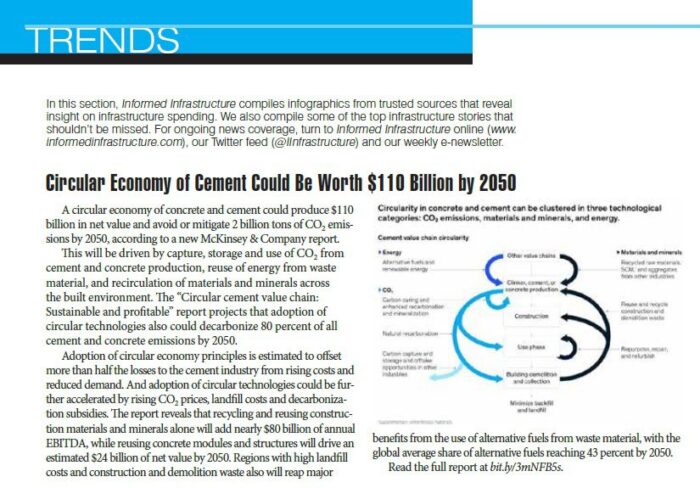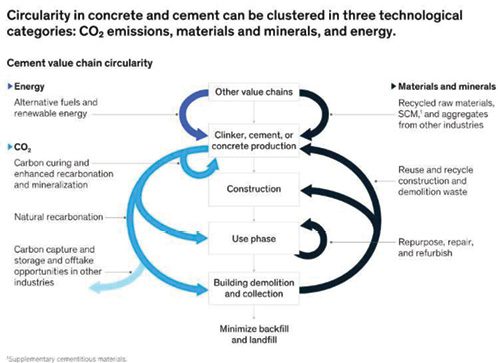Trends April 2023

In this section, Informed Infrastructure compiles infographics from trusted sources that reveal insight on infrastructure spending. We also compile some of the top infrastructure stories that shouldn’t be missed. For ongoing news coverage, turn to Informed Infrastructure online (www.informedinfrastructure.com), our Twitter feed (@IInfrastructure) and our weekly e-newsletter.
Circular Economy of Cement Could Be Worth $110 Billion by 2050

A circular economy of concrete and cement could produce $110 billion in net value and avoid or mitigate 2 billion tons of CO2 emissions by 2050, according to a new McKinsey & Company report.
This will be driven by capture, storage and use of CO2 from cement and concrete production, reuse of energy from waste material, and recirculation of materials and minerals across the built environment. The “Circular cement value chain: Sustainable and profitable” report projects that adoption of circular technologies also could decarbonize 80 percent of all cement and concrete emissions by 2050.
Adoption of circular economy principles is estimated to offset more than half the losses to the cement industry from rising costs and reduced demand. And adoption of circular technologies could be further accelerated by rising CO2 prices, landfill costs and decarbonization subsidies. The report reveals that recycling and reusing construction materials and minerals alone will add nearly $80 billion of annual EBITDA, while reusing concrete modules and structures will drive an estimated $24 billion of net value by 2050. Regions with high landfill costs and construction and demolition waste also will reap major benefits from the use of alternative fuels from waste material, with the global average share of alternative fuels reaching 43 percent by 2050.
Read the full report at bit.ly/3mNFB5s.
 FHWA Identifies $3.5 Billion Highway Funding Discrepancy
FHWA Identifies $3.5 Billion Highway Funding DiscrepancyA $3.5 billion discrepancy that dates back at least 18 years between the accounting systems used by the Federal Highway Administration (FHWA) and the U.S. Department of Transportation (USDOT) could negatively affect federal highway contract authority provided by formula to the states.
FHWA tracks more-comprehensive and detailed data, including program and project-level data used for paying invoices and reimbursements, via an accounting system called the Financial Management Information System, which shows an estimated $4.7 billion balance in contract authority authorized prior to the Infrastructure Investment and Jobs Act enacted in November 2021.
However, USDOT uses a different system called Delphi, which shows a $1.2 billion balance, to manage financial data at a higher aggregated level for all its modal agencies, which include FHWA but also the Federal Aviation Administration, Federal Transit Administration and Federal Railroad Administration, among others, and considers Delphi as its accounting “system-of-record.”
According to the FHWA, the discrepancy occurred during the changeover by USDOT to Delphi, sometime between fiscal years 2003 and 2005. FHWA and USDOT have been unable to find the root cause of the discrepancy, though they are reexamining FY 2004 through 2005 transactions to reconfirm that finding. Their analysis will indicate what remedial actions are required.
Updated ASTM Standard Available for HDPE HDD Projects
“ASTM F1962-22, Standard Guide for Use of Maxi-Horizontal Directional Drilling (HDD) for Placement of Polyethylene Pipe or Conduit Under Obstacles, Including River Crossings” was revised and updated in December 2022 by an ASTM Subcommittee led by Dr. Lawrence M. Slavin to include pipe made with PE 4710 compounds. In addition to ASTM, ASME and CSA standards, PE 4710 was incorporated in AWWA (C901, C906, M55), FM 1613 and others. The pipe is used in force main, potable water and other projects.
According to the Plastics Pipe Institute, PE 4710 is the highest performance classification of high-density polyethylene (HDPE) piping material for water applications.
Additional information can be found at the PPI Municipal & Industrial Division website at www.plasticpipe.org/municipalindustrial.
With air traffic poised to reach or beat pre-pandemic levels in 2023, the Federal Aviation Administration (FAA) is awarding nearly $1 billion from President Biden’s Bipartisan Infrastructure Law to 99 airports of all shapes and sizes across the country.
The funding helps meet the growing demand for air travel and invests in key areas to help get travelers in and out of airports more quickly and improve the passenger experience by investing in new baggage systems, larger security checkpoints and improved ground transportation. Other projects increase terminal sustainability and improve accessibility for individuals with disabilities. Several grants will address the needs of aging air-traffic-control towers. The investments will go to airports in 47 states and two territories.
An interactive data visualization of the airports receiving funding is at www.faa.gov/bil/airport-terminals.
Appropriations Set Stage for Stormwater Centers of Excellence
The U.S. stormwater sector soon will benefit from a centralized approach to infrastructure research and development thanks to $3 million in newly appropriated federal funding.
As part of the 2023 Consolidated Appropriations Act signed into law on Dec. 29, 2022, legislators provided $10.1 billion in funding for the U.S. Environmental Protection Agency (EPA)—nearly $600 million more than it received for the previous fiscal year. Much of that additional funding will enable EPA to carry out new programs authorized in the 2021 Infrastructure Investment and Jobs Act (IIJA). Among these provisions, the IIJA tasks EPA with designating between three and five Centers of Excellence for Stormwater Infrastructure Technologies (CESITs). While the latest round of appropriations did not fund every stormwater program authorized in the IIJA, the new influx will enable EPA to begin the process of identifying CESIT candidates.
TOP Stories
The following are the top stories from the last few months (in terms of traffic) on the Informed Infrastructure website. This also reflects key coverage areas that are regularly refreshed online and via our weekly e-newsletter. Simply search key words on Informed Infrastructure online to find the full story.
 Buildings
Buildings- HDPE Pipe Electrofusion Guide Updated
- AISI Publishes Supplement No. 3 to AISI S100-16 (R2020)
- World’s Tallest Timber Apartment Tower To Be Built in Zanzibar
- Climate Change and the Construction Industry: Small Changes with Big Impact
- Transbay Study Group Makes Recommendations
Transportation
- HNTB Partners with State DOTs to Deliver Plans for Electric Vehicle Infrastructure
- Zero Emissions Transit Announces Non-Profit Board That Will Oversee Approval and Implementation of Dodger Stadium Gondola
- Biden-Harris Administration Announces Bipartisan Infrastructure Law’s First Bridge Investment Program Grants
- U.S. Rural Road & Bridge Conditions, Safety & Funding Needs Examined in New Report
- Video: Vermont’s First Diverging Diamond Interchange
Water
- Water Utilities Set the Pace in Race to Reduce Carbon Emissions
- Modifying Water’s Structure as Low-Energy Method for Removing Pollutants
- Cleaner Wastewater Makes for Healthier Rivers
- Stantec-Freese and Nichols JV Awarded 5-Year Contract for Water/Wastewater Projects by U.S. Army Corps of Engineers
- Toyota Joins The Water Council’s WAVE Program
Tools and Technology
- Trimble Introduces Innovative Rail Module for Real-Time Monitoring Software
- Bentley Systems Launches iTwin Experience, iTwin Capture, and iTwin IoT to Extend iTwin Platform
- Linarc Launches All-in-One Cloud-Based Construction Project Management Software to Foster Collaboration and Efficiency for Mid to Large Scale Projects
- Enhancing Quality Across the Building Lifecycle: Nemetschek Brand Solibri Introduces Integrated Solution For Model Checking
- A New Hybrid Gateway with G.hn Backhaul Unveiled by MaxLinear and Microchip Technology for Versatile Smart Grid Use Cases


